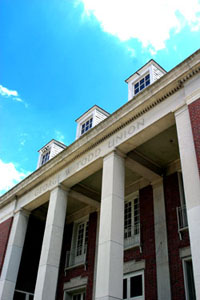
| ||||||
| ||||||

The theatre seems like an ideal place for a photographer: intensely dramatic situations happen right before your very eyes, and it can seem like the photographer doesn't really have to do anything. But my first experiences photographing Marivaux's The Triumph of Love in October 2003 taught me that even though the theatre is a place of unparalleled opportunity, it is also filled with hazards -- especially if one is doing unposed photographs (as all of mine are). For one, lighting is often extremely low, and when action happens quickly (as it invariably does), focusing becomes an enormous problem. What's worse, one has to be constantly on guard not to blow out the highlights, since there is so often an immense range of contrast in lighting values. Most of the time, I had the camera set to underexpose by a half or one full stop. There are other hazards as well. Since one is constantly moving around trying to find the best angle to shoot, there is a great potential for falling, slipping or knocking things over. This is especially the case when shooting rehearsals, since saws, electrical cords, or lamps may be lying around in extremely inconvienent places. Moreover, the use of theatrical blood, dust and water all can cause problems with equipment. And, the tension level of those involved in the production can occasionally get out of control, especially when there is disagreement on critical issues and a deadline is looming! Shooting in the theatre also demands planning.  For ten
of the twelve
productions I covered, I went to two rehearsals. Only when you know what
is about to happen can you plan in advance the most expressive camera
settings, angle, and moment of exposure to capture the best moment. Even
then, there is a great element of chance. For ten
of the twelve
productions I covered, I went to two rehearsals. Only when you know what
is about to happen can you plan in advance the most expressive camera
settings, angle, and moment of exposure to capture the best moment. Even
then, there is a great element of chance.
The perception of time works against one in the theatre. Moments that seem to carry on for a long time when sitting in the audience actually happen in a fraction of a second from behind the viewfinder. And, there are other moments that seem to last for an eternity after you've left the theatre and had time to reflect on what's happened. Those moments might last only a second or two when you're trying to photograph them. In a world where entertainment is often consumed at home in front of the television set, going out to the theatre can seem a hassle or an expenditure that isn't worth it. Actually, the opposite is true; we need the community of the theatre now more than ever. In an age where many of us experience life more and more through tiny white earbuds, video game consoles, and downloadable movies, live actors satisfy our need for a direct, personal connection. The increasing control that large corporations exercise over the kinds of media we consume (and even the way we consume it) has had terrible consequences for the ability of people to think for themselves. But in the theatre, we can still learn ways to gain a more nuanced and profound understanding of who we are. And, it's great fun, too! Now that my tenure as the photographer for the University of Rochester's International Theatre Program is at its end and I depart Rochester, I hope that the photographs I leave behind will communicate the immense joy I had working along all those involved in this project -- actors, crew, and supporters. And, I'd like to especially thank my grandmother, whose posthumous contribution helped to make this possible. | ||||||
|
